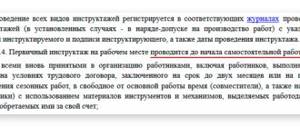What is considered a fight at work?
When a fight occurs at work, the Labor Code does not require the manager to perform any actions or apply certain measures, even if this is an administrative violation or crime. If the fact of the fight was not reported, then this is also not a violation.
On the other hand, the legislation provides for a number of possible measures that can be used to influence troublemakers. It is important to understand that liability within the framework of the implementation of labor legislation differs from that which arises as a result of the application of administrative or criminal law.
These types of liability occur independently. For example, if during a fight that occurred at work, a person was injured, then this entails criminal liability for the perpetrator, regardless of whether it happened at the workplace or not.
A completely different situation arises if the fight did not entail consequences that fall under a criminal article: for example, there were no serious injuries, theft or the like. In this case, the main type of punishment becomes that associated with violation of labor laws.
It is this type of violation that is discussed in this article.
Is a fight considered a work injury?
First, we need to consider what the law considers to be a work-related injury.
We are talking about harm to the employee’s health. This can be done on-site during the workday or off-site during a work assignment.
It is important to note that this category includes damage received during lunch breaks, other time periods provided by the enterprise for employee rest, during preparation for the start of work, or while processing took place.
After an injury has occurred, the employer is obliged to create a commission that will investigate what happened and draw a conclusion about what it happened. If such an investigation was carried out at an enterprise in violation of established rules, the state labor inspector has the right to conduct it again.
An industrial injury cannot be considered damage that occurs as a result of alcohol or drug intoxication. This is also unacceptable in cases where the victim has committed a criminal offense.
The nature of such offenses
In order for the manager to take action, it must be about the fact of violation of the provisions of labor legislation. At the same time, the question arises about what kind of violations took place, if there was a fight at work, what exactly was violated in this case.
To better understand the situation, here are some examples of this type of situation:
- One employee constantly picks on another, driving him crazy. Finally, he can’t stand it and rushes at him with his fists.
- The head of the department instructs the employee to complete the work. He is not in the mood and responds with rudeness. The boss finds this outrageous and hits him, wanting to punish him for insubordination.
Even if no one is particularly harmed, the enterprise will actually be damaged.
Employer's actions
As soon as the fight becomes known, the need arises:
- understand what really happened;
- determine what damage has been caused to the health of employees;
- find out the amount of material damage to the enterprise;
- determine the degree of guilt and responsibility of everyone who participated in the fight.
In the event of a fight, the manager has the right to request an explanation in writing.
After the incident, it is necessary to request explanations in writing from those directly involved in the conflict. Testimonies from participants will help to understand the situation in detail.
Unfortunately, we cannot exclude the possibility that all or some participants will refuse to submit written explanations. At the same time, you need to understand that the boss is in any case obliged to understand the facts that took place and make his decision.
Let us note that the law does not require a mandatory response, however, if the causes of the conflict are not eliminated, this may lead to serious consequences in the future. The manager has the right to take measures in connection with violation of labor discipline by employees. These include actions or inactions that resulted in complete or partial failure to fulfill labor duties by the perpetrator.
Compensation for damage caused
A violent fight at work can cause damage to property in the form of damage to inventory items on the organization’s balance sheet.
To bring the offending employee to financial responsibility, the employer must:
- create a commission with the participation of specialists to assess the cost of harm caused in monetary terms;
- obtain an explanation from the employee confirming guilt and readiness for compensation; the refusal is accompanied by the drawing up of an appropriate act;
- If he agrees, the employee can voluntarily contribute the required amount in full or in parts during a specified interval, or write a statement of deduction from accrued wages.
If an employee chooses a method of compensation in the form of deductions from current payroll accruals, the employer is obliged to remember the maximum possible amount withheld, which is no more than 20% of the wages due to be received in “pure form”. The decision must be made within a month after the expert commission determines the material damage caused.
If the assessed amount of damage is higher than the average monthly earnings of the employee or the citizen refuses compensation, then the “fate” of receiving the money due to the enterprise or entrepreneur is decided in court. The court may decide to carry out repairs of the damaged property on its own or at the expense of the personal financing of the person found guilty.
How to report an incident
The first step is to obtain explanatory notes from everyone who participated in the conflict. It is important to obtain information from all parties. After all, the causes of a conflict cannot always be determined at first glance.
For a fight, an employee may be subject to disciplinary action up to and including dismissal.
Perhaps one of the employees would also like to provide an explanation in connection with what happened.
Employees may refuse to provide explanations. They have the right to do so. However, they are given two working days to submit information. If they did not do this, it will be necessary to draw up a report where it will be recorded that the employee who participated in the fight refused to provide his written explanations.
Having received all available information, the director must decide to take appropriate disciplinary action. There are three types of such measures:
- comment;
- rebuke;
- dismissal.
In this case, the first or second option can be used at the discretion of the boss. In order to apply dismissal, it is necessary that there be a basis provided for by the Labor Code.
An example of the latter option could be, for example, a situation where employees perform educational functions and get into a fight in front of schoolchildren.
Responsibility for repeated violation of the work schedule
I would recommend that complaints against an employee be based not on a fight, but on numerous violations of the work schedule. The only thing is that they must be documented: violations of the working hours by employees must be reflected in the working time sheet. If an employee has a clearly defined start and end of the working day, then during this time he must be at work and perform his job duties. If he leaves early, it is a misdemeanor, regardless of whether he arrived before the allotted time or not. If you, as an employer, were not against such a shift in the working day to an earlier time while maintaining its duration, then you could stipulate such an individual work schedule in his employment contract. The employee cannot do this independently, without coordinating this issue with the employer. Therefore, here it is necessary to follow the technical procedure for imposing a disciplinary sanction, provided for in Art. 193 of the Labor Code of the Russian Federation. But be sure to pay attention to compliance with the deadlines for issuing a disciplinary sanction; perhaps, in some cases of violation of the work schedule, a period of one month has passed from the date of discovery of the offense.
If you have not previously imposed disciplinary sanctions on an employee and the deadlines for them have passed, still record these violations, so that in the event of a trial you have documentation that the violations occurred more than once, but no disciplinary sanction was issued. In addition, be sure to record all the circumstances of the fight, and decide whether to impose a disciplinary sanction or not depending on whether some kind of prohibition or requirement was prescribed that the employee violated, and whether the deadlines still allow for applying a disciplinary sanction.
Explanatory
When a violation occurs, the employee is asked to write an explanatory note. Two working days are allotted for this. He can write this document or refuse.
The purpose of obtaining explanations is that it is necessary:
- understand what happened;
- find out who is responsible for the fight;
- find out the degree of guilt of a particular employee.
If the employee does not give an explanation, then the Labor Code of the Russian Federation provides that an act must be drawn up, which will set out all the circumstances of the incident.
Question
My warehouse manager (in-house) got into a fight with a supplier representative (outside employee) on our company premises. In explanatory notes they write opposite explanations and refer to each other’s guilt. Is it possible to fire him for fighting? He has a certificate of visual disability. In addition, he constantly violates labor discipline, leaving the workplace 30-60 minutes before the end of the working day. He explains this by saying that he arrives 30-60 minutes earlier, although the working hours are clearly stated in the employment contract.
What does a fight mean to an employee?
Liability for a fight can be determined by several different circumstances:
- A person who does not respect his company and colleagues can hardly count on a successful career. A fight at work also shows what the person who is responsible for it is like.
- In any case, the culprit violates labor discipline at his company. Firstly, he wastes his working time on it, and secondly, he creates a certain atmosphere in the team that is not conducive to effective work.
- This may cause damage to your health and that of your company's employees.
- There may be property damage that will most likely have to be fully compensated.
- Punishment under labor legislation does not exclude administrative or criminal liability if there are legal grounds for this.
Disciplinary punishment does not exclude criminal liability for a fight
In general, it can be stated that it is better to avoid fights even in situations where this is difficult to do. As a result, there may be many more problems than we would like.
Disciplinary action
Article 193 of the Labor Code provides for the following procedure when imposing such a penalty:
- The boss is obliged to demand from the offending employee an explanation of what happened in writing.
- The employee has the opportunity to ignore this instruction. However, the waiting time is no more than two days. When the period expires, a report is drawn up regarding the fact of the violation.
- There is a time limit that limits the time at which disciplinary measures can be taken. It cannot exceed one month. This time does not include absence due to illness or time spent on vacation.
- If the enterprise has a representative body that protects the rights of employees (for example, a trade union organization), then in further actions it is necessary to take into account the opinion expressed by it. The time he waits is not included in the monthly period limiting the boss’s right to take disciplinary measures.
- For each offense, only one penalty is possible. It is announced in an order signed by the head. The employee is introduced to it within three days. If the employee refuses to sign for familiarization, a corresponding report is drawn up.
Answer
The application of disciplinary action and subsequent dismissal for fighting is possible when, firstly, the employee violated official or labor duties, and secondly, the procedure established by labor legislation was followed.
So let's understand the fight situation. Could this be interpreted as a violation of work duties? Purely theoretically, it can, if the local regulations of the organization specify requirements for compliance with business ethics of communication in the company, polite treatment of colleagues, etc. Then, if the employee was familiarized with this act against signature and during the internal investigation, you understand that in the situation is his fault (that is, he was not attacked, but he took an active part in the fight), a disciplinary sanction can be imposed on him.
But, of course, the situation is ambiguous, since a fight does not fall within the scope of labor relations, but is an administrative offense or a criminal offense (depending on the consequences of the fight), so this issue could be resolved with the involvement of the police.
Dismissal under article
In some cases, the result of a fight may be termination of the employment contract. Usually, paragraph 5 of Article 81 of the Labor Code of the Russian Federation is used for this. But this can be done if the company applies internal rules.
If the employment contract is terminated in accordance with the specified grounds, then this is one of the types of disciplinary action. In this case, the manager is obliged to comply with the provisions of Article 193 of the Code.
One of the requirements is that dismissal can only occur on the grounds provided for by the Labor Code of the Russian Federation. It is necessary that this disciplinary violation is not the first.
For information on the types and rules for applying disciplinary sanctions, watch this video:
Is it possible to fire an employee for fighting?
By decree of the People's Commissariat of the Russian Federation of 04/05/21, fights in enterprises were transferred to the disciplinary comradely courts. Such courts had fairly broad powers. Violators could be subject to serious punishment, including transfer to hard forced labor and exile to a correctional camp.
The table of penalties attached to the Model Internal Regulations for Industrial Enterprises of 1927 allowed for the dismissal of an employee for three fights in a year. One and the buckets were punishable by a reprimand and an announcement to the workshop or department.
What should we do now with employees whose fists itch? It must be stated right away that employers are not obliged to take any measures in connection with a fight at their premises. Fights are not considered industrial accidents (Part.
1 tbsp. 227 of the Labor Code of the Russian Federation), therefore their investigation does not fall within the competence of the employer. Non-reporting is not punishable by law.
What is the threat to the organization?
The damage caused can be of the following types:
- material damage;
- violation of labor discipline in the team.
In the first case, the amount of damage incurred is determined separately. Damage may be recovered in accordance with the law.
In a normal situation, we can talk about an amount that does not exceed the average monthly salary. If the employee is found to be at fault, the damages can be recovered in full.
To recover damages, the manager must do the following:
- Prove that there are no circumstances that eliminate or limit the employee’s financial liability.
- It is necessary to prove that the employee’s action or inaction is unlawful.
- It is necessary to provide evidence of the employee’s guilt in the damage caused.
- It is necessary to convincingly prove the existence of a cause-and-effect relationship between the actions taken and the damage caused to the enterprise.
- It is necessary to confirm the fact that direct and actual damage has been caused.
- It is important to assess the amount of damage caused as accurately and objectively as possible.
The presence of these conditions may become the basis for full recovery of damages incurred. Article 21 of the Labor Code of the Russian Federation provides for the duty of an employee to take care of the property of the enterprise where he works.
Disputes with employees: 7 ridiculous mistakes that caused companies to lose
Employers are increasingly winning over employees in dismissal disputes. However, it happens that the company incorrectly applied the law or did not properly prepare for dismissal. Then you will have to reinstate the employee, pay wages for the period of forced absence and, possibly, pay a fine.
The editors of the Commercial Director magazine reviewed 7 common mistakes made by managers to protect you from court decisions in favor of employees.







